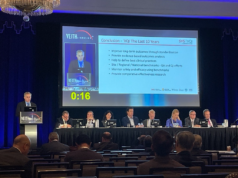 Transluminal injection of foam sclerotherapy (TLFS) combined with endovenous laser ablation (EVLA) is a safe and feasible procedure that improves venous clinical severity score (VCSS) and reduces additional second-stage interventions compared to ultrasound-guided foam sclerotherapy (UGFS) combined with EVLA. This is according to the findings of a randomised controlled trial recently published online in the Journal of Vascular Surgery: Venous and Lymphatic Disorders.
Transluminal injection of foam sclerotherapy (TLFS) combined with endovenous laser ablation (EVLA) is a safe and feasible procedure that improves venous clinical severity score (VCSS) and reduces additional second-stage interventions compared to ultrasound-guided foam sclerotherapy (UGFS) combined with EVLA. This is according to the findings of a randomised controlled trial recently published online in the Journal of Vascular Surgery: Venous and Lymphatic Disorders.
In this study, Satoshi Watanabe (Watanabe Hospital, Osaka, Japan) and colleagues set out to compare the safety, need for additional foam sclerotherapy, and one-year VCSS improvement in limbs of chronic venous disease patients with great saphenous vein (GSV) reflux treated via EVLA (1,470nm diode laser) and concurrent foam sclerotherapy (1% polidocanol) through the access sheath (TLFS) to those treated with EVLA and concurrent direct-puncture UGFS.
The authors write that they screened 467 patients, or 577 legs, with symptomatic primary GSV reflux for randomisation to either TLFS with EVLA (103 legs; TLFS group) or UGFS with EVLA (94 legs; UGFS group).
Patients with recurrent varicose veins after a previous intervention, hypersensitivity reaction to sclerotherapy, acute deep vein thrombosis, serious lower-limb ischaemic disease, coagulation disorder, and simultaneous EVLA of both GSV and small saphenous veins, were excluded from the study, the investigators write.
Watanabe and colleagues report that they observed no significant differences in the distribution of Clinical-etiology-anatomy-pathophysiology (CEAP) classification between the groups. After 12 months of follow-up, they add, all truncal veins were occluded.
The authors further relay that VCSS was significantly improved in the TLFS groups compared to the UGFS group (UGFS, -7.4±1.8; TLFS, -8.7±1.5; p<0.0001). Furthermore, they note that multivariate analysis revealed that TLFS was the only significant factor for improved VCSS (hazard ratio, 0.63; 95% confidence interval, 0.32–0.96; p<0.0001), and that additional second-stage sclerotherapy was significantly avoided in the TLFS group (n=10 [10%]) compared to the UGFS group (n=51 [54%]; p<0.0001).









